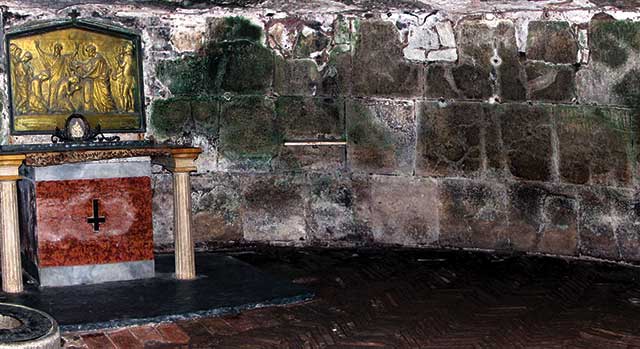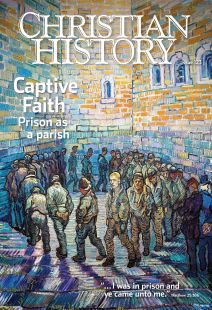Prison as a parish: Christian responses
FROM JOSEPH'S IMPRISONMENT in Genesis to Satan’s in Revelation, references to prisons fill the Bible. And Christians have spent considerable effort on how best to respond to crime and punishment, imprisonment and release. They have sought to minister to prisoners; they have tried to influence the justice system; and their input became crucial in the rise of the modern-day prison.
Proclaiming freedom
Biblical testimony in general speaks little of verdicts of crime and punishment and more of mercy and fellowship. In Genesis we read of Potiphar imprisoning Joseph and how “the Lord was with Joseph and showed him steadfast love” (Gen. 39:21). Psalm 107 depicts those rightly imprisoned for rebelling against God’s word, and yet, when “they cried to the Lord in their trouble … he saved them from their distress … and broke their bonds asunder” (vv. 13–14). The prophet Isaiah declared that God had called him “to proclaim freedom for the captives and release from darkness for the prisoners” (Isa. 61:1).

[Mamertine prison in Rome, where Peter and Paul may have been held. Wikimedia.]
Jesus echoed Isaiah’s words, as recorded in Luke’s Gospel, “The Spirit of the Lord is on me, because he has anointed me to preach good news to the poor. He has sent me to proclaim freedom for the prisoners”
(Luke 4:18). The Book of Hebrews commends us “to remember those who are in prison, as though in prison with them” (Heb. 13:3). And in Matthew’s Gospel, we discover that to visit the prisoner is in fact to visit Jesus himself (Matt. 25:36).
For its first three centuries, the early church had little influence over Roman law concerning crime and punishment. Things changed, however, by the early fourth century with Emperor Constantine’s legalization of Christianity. Not only did Constantine eliminate persecution of Christians, but in 320 he issued an edict limiting mistreatment of prisoners awaiting their day in court. It literally loosed the chains of the prisoners to eliminate undue pain in their wrists or ankles. Prisoners were to be kept in good health, not tortured or mistreated.
Indeed Christianity seems to have had a significant impact on the Roman Empire’s treatment of prisoners. Jailers would often allow imprisoned Christians gifts and even visitors as they awaited trial and sometimes execution. And judges got a first-hand look at prisons every Sunday, when they confirmed the prisoners had enough food and access to bathing. One edict in 367 released a large number of prisoners in honor of Easter.
Such changes were significant for the Roman Empire, whose criminal justice system could be extreme, arbitrary, and unforgiving. In the time of Augustine (354–430), punishments were severe. Some offenders were hauled off and banished from the realm, but others faced beatings, torture, or death. Prisons were used as holding places until judgment or as short-term punishment for lesser crimes. Long-term prison sentences were uncommon, and Christians most often protested the state’s use of punishment and not prison sentences.
Augustine took up this cause in his sermons, teaching that criminal punishment should aim for moral and spiritual rehabilitation of the criminal, redirecting the criminal to the true good of society, and ideally to God. He acknowledged that punishment had its place in a just society, but thought a “deserved punishment should always be imposed as gently as possible.”
Augustine taught that one of the roles of a bishop is to re-establish the offender as part of the Christian “fellowship of the altar,” acting as an intercessor between the criminal, the state, and the church. He personally pleaded with civil authorities to mitigate the punishment of criminals, especially capital punishment. In the end his driving force was Jesus’ commandment to love one’s neighbor and even one’s enemy:
The only person who is fit to punish anyone is the one whose love has overcome the hatred which often rages in us when we desire revenge. … The goal in such ideal cases is not to make the wrongdoers miserable through punishment but to bring them happiness through correction.
The poor in Christ
In the Middle Ages, religious orders and Christian laypeople took up the cause of the downtrodden in earnest. They established hospitals and organized aid to the poor, the sick, abandoned children, the elderly, and pilgrims. By the twelfth century, they included prisoners, often called “the poor in Christ,” in these efforts, and an obligation of charity for the imprisoned became commonplace for Christians.
It wasn’t long before church leaders and magistrates brought their case to medieval kings, who in turn granted acts of mercy to prisoners. Influence also came from monasteries. According to the Rule of St. Benedict, wayward monks were to be confined, “walled up,” and required to do penance for their sins, with a goal of reconciliation with the monastic community. In time the wider society began to use the monastic goal of confinement producing penitence in addition to punishment.
In early modern Europe, severe corporal punish-ment for crimes lessened and other punishments emerged. The church and the state often shared jurisdiction over those convicted of crimes. Ecclesiastical judges often gave milder sanctions than did other judicial bodies, such as military courts.
For instance a church judge might require an offender to wear a penitential garment for a period of time or go barefoot while dressed in a sheet through the public square. At times ecclesiastical judges would withhold punishment and simply require a fine. Over time the practices of religious courts spread to the secular realm. Of course early modern European governments still used harsher punishments, such as torture or execution, but the church’s influence had a mitigating effect.
For many sixteenth-century reformers, the moral law, sometimes referred to as the natural law, had several so-called uses. First the moral law had a civil use, restraining people from criminal conduct. Second it had a theological use, condemning those who fell short of God’s law. Finally the moral law had an educational use, teaching people how to conduct their lives before God and with others.
This understanding of the uses of the moral law can be seen in various legal conceptions of criminal law, especially in England and America. Early modern jurists saw themselves as God’s vice-regents in the world, God’s authority on earth. As such, penal law was meant to reflect God’s moral law—seeking to judge immorality, condemn sinfulness, and educate the offender to rehabilitate, reform, and ultimately rejoin society.
The state of the prisons
Much agitation for prison reform came from the work of John Howard (1726–1790) in England. High sheriff of Bedfordshire and survivor of a brief imprisonment, he refused to delegate his duties of inspecting the county jail, going there himself. He was so horrified by what he found that he ended up visiting prisons throughout the country and publishing the exposé The State of the Prisons in England and Wales (1777).
There he described the many prisons he had visited, such as this one: “Two dirty day-rooms; and three offensive night-rooms: That for men eight feet square: one of the women’s, nine by eight; the other four and a half feet square: the straw, worn to dust, swarmed with vermin: no court: no water accessible to prisoners. The petty offenders were in irons: at my last visit, eight were women.” Out of his work came the Penitentiary Act of 1779, which prescribed solitary confinement, religious instruction, hard labor, and the abolishment of jailer’s fees. He eventually toured European prisons as well.
American reformers also pushed for a prison discipline that would rehabilitate and not merely punish, but they were not always successful (see “Heaven at last the wrong shall right,” pp. 33–35). US penitentiaries were divided between the “Pennsylvania system” and the “Auburn system.” The first kept prisoners in solitary confinement at all times, and the second allowed them to work together in silence during the day.
 Order Christian History #123: Captive Faith: Prison as Parish in print.
Order Christian History #123: Captive Faith: Prison as Parish in print.
Subscribe now to get future print issues in your mailbox (donation requested but not required).
Even as Howard and others were pressing for reform, imprisonment was growing more popular. By 1790 in England, approximately two-thirds of criminal sentences entailed imprisonment. In 1785 British philosopher Jeremy Bentham designed a prison called a panopticon where a central jailer could observe all prisoners. Bentham’s design served as the basis for many prisons built thereafter.
By the 1800s it was thought that “idleness and labor” within prison walls could be opportunities for moral reflection, penance, and changed behavior—just as they had been for medieval monks. With the added emphasis on the educative use of the moral law, a combination of forced labor and solitary reflection came to be seen as an opportunity for rehabilitation, not just punishment. In contrast to earlier eras, Christians formed “societies for the reformation of manners” and promoted imprisoning those who had committed low-level offenses.
Quakers like Elizabeth Fry and William Penn were key to the modern prison’s development, galvanizing various sectors of society—judicial, religious, and civil—to deal with crime, punishment, and prisons (see CH issue 117). Fry’s visits to Newgate, where she found appalling conditions, led directly to a new wave of prison reform. Her biographer wrote of the scene: “Nearly three hundred women, with their numerous children, were crowded … in rags and dirt, destitute of sufficient clothing (for which there was no provision), sleeping without bedding, on the floor. … The prisoners purchased liquors from a regular tap in the prison.”
Quakers called for the abolishment of capital punishment and a role for religion in defining the purpose of prison. They denounced bodily punishment, promoted personal contact and influence, and made great effort to organize voluntary groups of Christians and concerned citizens to regularly visit prisoners.
As a result of these reforms, the modern-day prison began to aim at providing something much like the monastic experience of work and solitude as an opportunity for moral and spiritual reform. Prisons are intended to be communities of moral and spiritual fellowship, creating and sustaining social bonds between prison staff, inmates, and even those outside the prison. That is the ideal, at any rate.
Ministering inside and out
Modern Christians involved in prison ministry, like their predecessors, try to attend to physical and spiritual needs of prisoners and to work for more just laws and more humane treatment. Prison Fellowship, for example, evangelizes prisoners, but also offers life-skills and re-entry training, trains wardens, works with families, and does legal advocacy. Educational programs, like the long-standing branch of the New Orleans Baptist Theological Seminary inside the Louisiana State Penitentiary, attempt to transform the system from the inside (see “Joys and challenges,” pp. 37–40).
Christian influence on crime and punishment in the West has been considerable; perhaps most striking is the Christian insistence on giving criminals opportunities for moral and spiritual rehabilitation. Today the United States leads the world in incarceration rates, including for minor crimes. The question is whether Christians will continue the church’s long legacy of showing mercy to “the poor in Christ.” CH
This article is from Christian History magazine #123 Captive Faith. Read it in context here!
By Todd V. Cioffi
[Christian History originally published this article in Christian History Issue #123 in 2017]
Todd V. Cioffi is an assistant professor of congregational and ministry studies at Calvin College and the codirector of the Calvin Prison Initiative.Next articles
William Morgan’s gift
An obscure Irish teenager inspired Methodists to Undertake over 200 years of prison ministry
Kevin M. Watson“Heaven at last the wrong shall right”
One man’s thwarted attempts to change American prisons
Jennifer GraberSupport us
Christian History Institute (CHI) is a non-profit Pennsylvania corporation founded in 1982. Your donations support the continuation of this ministry
Donate





